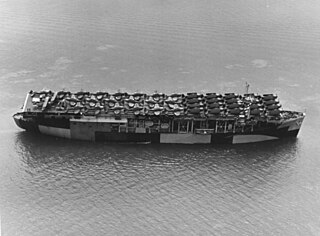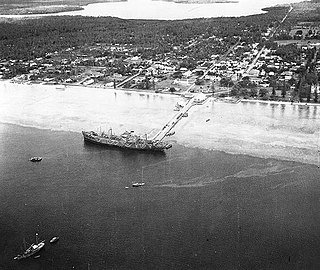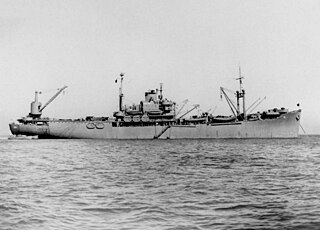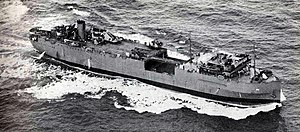
USS Long Island (CVE-1) was lead ship of her class and the first escort carrier of the United States Navy. She was also the second ship to be named after Long Island, New York.

USS Pensacola (CL/CA-24) was a cruiser of the United States Navy that was in service from 1929 to 1945. She was the lead ship of the Pensacola class, which the navy classified from 1931 as heavy cruisers. The third Navy ship to be named after the city of Pensacola, Florida, she was nicknamed the "Grey Ghost" by Tokyo Rose. She received 13 battle stars for her service.

USS Nassau (CVE-16) was laid down 27 November 1941 by the Seattle-Tacoma Shipbuilding Corporation of Tacoma, Washington, as M.C. Hull No. 234; launched 4 April 1942; sponsored by Mrs. G. H. Hasselman, Tongue Point, Oregon; acquired by the Navy 1 May, towed to the Puget Sound Navy Yard, Bremerton, Washington, and converted to an escort carrier; and commissioned 20 August, Captain Austin K. Doyle in command.

USS Altamaha (AVG-18/ACV-18/CVE-18) was an escort aircraft carrier in the United States Navy during World War II. She was named for the Altamaha River in Georgia.

USS Nashville (CL-43) was a Brooklyn-class cruiser. She was laid down on 24 January 1935 by New York Shipbuilding Corporation, Camden, New Jersey. She was launched on 2 October 1937, sponsored by Misses Ann and Mildred Stahlman and commissioned on 6 June 1938.

USS Manley (DD-74/AG-28/APD-1), a Caldwell-class destroyer, served in the United States Navy. She was the second Navy ship named for Captain John Manley (c.1733–1793).

The second USS Solace (AH-5) was built in 1927 as the passenger ship SS Iroquois by the Newport News Shipbuilding and Drydock Co., Newport News, Virginia. The liner was acquired by the Navy from the Clyde Mallory Steamship Line on 22 July 1940, renamed Solace (AH-5); converted into a hospital ship at the Atlantic Basin Iron Works, Brooklyn, N.Y., and was commissioned on 9 August 1941, Captain Benjamin Perlman in command.

USS Wright (AZ-1/AV-1) was a one-of-a-kind auxiliary ship in the United States Navy, named for aviation pioneer Orville Wright. Originally built as a kite balloon tender, she was converted into a seaplane tender after kite balloons were no longer used.

USS Thornton (DD-270/AVD-11) was a Clemson-class destroyer in the United States Navy during World War II. She was named for James and Ryan Thornton, naval officers during the American Civil War, and was the second ship to bear this name.

USS Gwin (DD-433), a Gleaves-class destroyer, was the third ship of the United States Navy to be named for Lieutenant Commander William Gwin, an American Civil War officer who commanded river boats against Confederate forces in Alabama.

USS Spangler (DE-696) was a Buckley-class destroyer escort of the United States Navy.

USS Woodworth (DD-460) was a Benson-class destroyer in the United States Navy during World War II. She was named for Commander Selim E. Woodworth.

USS Betelgeuse (AK-28/AKA-11) was an Arcturus-class attack cargo ship, the first United States Navy ship named for Betelgeuse, a star in the constellation Orion. She served as a commissioned ship for 4 years and 9 months.

USS Whitley (AKA-91) was an Andromeda-class attack cargo ship in service with the United States Navy from 1944 to 1955. In 1962, she was transferred to Italy were she served as Etna (L9870) until she was scrapped in 1979.

USS Libra (AK-53/AKA-12/LKA-12) was an Arcturus-class attack cargo ship named after the constellation Libra. She served as a commissioned ship for 11 years.

USS Alchiba (AKA-6) was an Arcturus-class attack cargo ship of the United States Navy, named after Alchiba, a star in the constellation Corvus. She served as a commissioned ship for 4 years and 7 months.

USS Pocomoke (AV-9) was a Pocomoke-class seaplane tender, originally built as the SS Exchequer and acquired by the U.S. Navy as the military build-up occurred in the United States just prior to World War II. She operated principally in the Pacific Theatre of the war and serviced military seaplanes. At war’s end, she returned to the United States with two battle stars.

USS Chandeleur (AV-10), a seaplane tender, was launched on 29 November 1941 by Western Pipe and Steel Company, San Francisco, California, under a Maritime Commission contract; transferred to the U.S. Navy 19 November 1942; and commissioned the same day.

USS Vireo (AM-52) was a U.S. Navy Lapwing-class minesweeper, No. 52, reclassified on 1 June 1942 as a fleet tug. The bulk of her combat career was served in this capacity.

USS Crescent City (AP-40/APA-21) was the lead ship of the Crescent City-class attack transports that served with the US Navy during World War II. The ship was built as the cargo and passenger liner Delorleans for the Mississippi Shipping Company's Delta Line. After brief commercial operation the ship was among 28 vessels requisitioned in June 1941 for the Navy and the Army. The Navy renamed the ship Crescent City, a popular nickname for New Orleans, Louisiana, upon commissioning 10 October 1941. The ship was decommissioned and laid up in 1948 before being loaned to the California Maritime Academy to serve as a training ship 1971–1995 and then transferred to a foundation in a failed art colony project. The ship left California for Texas scrapping in 2012.





















